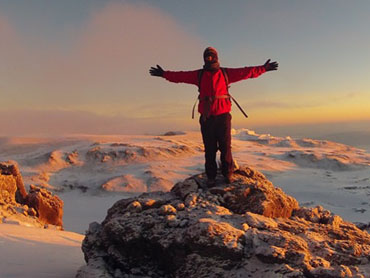- Email: info@billiahsafaris.com
6 Days Marangu Route
6 Days Marangu Route
$ 1,600
Overviews
It is considered to be the easiest path on the Mountain, popularly known as
Coca Cola route. Given its gradual slope and direct path, Marangu is the only Route which offers sleeping huts in dormitory style accommodation. There are 60 bunk beds each at Mandara and Kibo Huts and 120 bunk beds at Horombo Hut. Guests are supplied with mattresses and Pillows, but sleeping bags are still required. The huts have communal dining halls and basic washrooms, ranging from flushing toilets and running water at the lower huts to long drop toilets and buckets of water at Kibo Hut.
Marangu route is a classic trek to the top of Kilimanjaro. However, it has the Least scenic variety of all routes (ascent and descent are done on the same path)and is the most crowded for that reason.
Also would appreciate if you can give us the additional costs for :
- Portable hot water shower – $300/-
- Bottles of water – No Plastic Allowed So Not Possible.
- Soft drinks – No Plastic Allowed So Not Possible.
- Oxygen cylinder – $200/-
- Personal supplemental oxygen cylinder – Same as the above.
- Amref Flying Doctors ‘Maisha’ Air Ambulance cover- the costs/ cover details – $30/- pps
WHAT TO PACK FOR KILIMANJARO CLIMB
- Rain jacket (fully waterproof with hood)
- Rain pants (full-length side zippers work well to take on and off quickly)
- Sweat-wicking T-shirts / vests
- Fleece (Polar Tec 300 grading or similar)
- Insulated down jacket or similar
- Down mittens or similar
- Lightweight gloves for non-summit days
- Thermal Long-Johns or compression tights for summit night
- Lightweight walking trousers (avoid jeans or heavy cotton as they chafe and dry slowly)
- Underwear (lyre shorts and/or briefs are usually better than boxer shorts which gather and chafe)
- Very good quality hiking socks and thin liner socks. (We advise that socks should be at least a size too small otherwise they stretch and bunch causing blisters)
- Breathable lightweight waterproofs (jacket and trousers).
- Waterproof walking boots, sturdy and worn-in. A Gore-Tex membrane or similar is advised. While Alpine or C3 boots are not required for Kilimanjaro it is important that your boots have good ankle and arch support and good deep read patterns.
- Calf gaiters
- Balaclava
- Gore-Tex Mountain Cap or Woolen Hat
- Wide-brimmed sun hat to protect face, ears, and neck
- Hygiene Related Gear for Use on Kilimanjaro
- Lightweight travel towel
Include & Exclude
Include
- Pick up from the Hotel and transfer to Marangu Gate – Return
- All Park entry fees
- Guides and Porters Salaries (Exception of Tips)
- Hut Fees
- Food and water for the entire expedition
Exclude
- Tips (optional)
Itinerary
-
Day 1 - Marangu Gate (1843m) To Mandara Hut (2700m) Time: 4- 5 Hrs Distance: 8kms Or 5 MilesPick up early from Arusha hotel and transfer to Moshi for a climb briefing before transferring to The National Park Gate (1,830 m.) lies at the edge of Marangu, which is an attractive village with many small coffee and banana plantations. After completing the entrance formalities, we climb up through an attractive and unspoilt forest to reach the clearing containing Mandara Hut (2,700 m.), a group of comfortable ’A’ frame wooden huts. The largest cabin has a downstairs dining area and an upstairs dormitory and mattresses. Smaller huts sleep eight persons. The total capacity is sixty persons. Water is piped onto site from a spring above and there are flush toilets behind the main cabin. The volcanic remains of Maundi Crater are nearby and make a good afternoon excursion. An alternative is to rest and enjoy the beautiful forest. There is rich birdlife at the huts and monkeys are often seen as well. (3-5 hours walking) Overnight at Mandara hut on the mountain on a full board basis
-
Day 2 - Mandara Hut (2700m) To Horombo Hut (3720m) Time: 6 – 8hrs) Distance: 12kms Or 7 Miles
The first part of the walk is a steep ascent through the forest, but the path soon opens out into grassy moorland and in clear weather, there are good views of Kibo and Mawenzi peaks. We climb steadily through the moorland zone, containing giant heathers and occasional stands of groundsel, to eventually reach the hut complex at Horombo (3,720 m.). The buildings here are similar to Mandara Hut, but total capacity is one hundred and twenty persons. Water is piped from the stream behind the huts. There are platform toilets south east of the main hut, about eighty metres down the slope and flush toilets have been built within the complex of small huts. Sunrises and sunsets here are often spectacular and the site is close to the glaciated dome of Kibo. There is a real sense of being above the clouds here. (4-6 hours walking) Overnight at Horombo hut on the mountain on a full board basis
-
Day 3 - Horombo Hut (3720m) To Kibo Hut (4703m) Time: 6 – 8hrs Distance: 10kms Or 6 Miles
We climb very gradually towards the lunar desert of the Saddle between Mawenzi and Kibo. The terrain changes to scree and there is a palpable sense of high altitude wilderness. We usually reach Kibo Hut (4,700 m.) at the bottom of the crater wall by midday. Kibo is a stone-built block house with a small dining area and a number of dormitory rooms leading off a main corridor. There are bunk beds and mattresses for about sixty people. There is no water here so one has to bring an ample supply from the ’last water’ supply above Horombo Hut. Platform toilets are behind the hut. The remainder of the day is spent resting and eating in preparation for the final climb before a very early night! (4-5 hours walking) Overnight at Kibo Hut on the mountain on a full board basis
-
Day 4 - Kibo Hut (4703m) To Uhuru Peak (5895m) To Horombo Hut (3720m) Distance: 6kms Or 4 Miles, Time: 6 – 8hrs
We will start our ascent by torchlight at about 0100 hours, aiming to be up at Gillman’s Point by sunrise. The initial climb is steep over loose volcanic scree, but there are some well-graded zig-zags and a slow but steady pace will have us up to Gillman’s (5,685 m.) in about five or six hours. We will rest there and spend some time taking in the sunrise. For those who are still feeling strong can make the three hour round trip from here along the crater rim to Uhuru Peak (5,896 m.), passing close to the spectacular glaciers that still occupy most of the summit area. The descent is surprisingly fast and we return to Horombo for the night. (11-15 hours walking) Overnight at Horombo Hut on the mountain on a full board basis
-
Day 5 - Horombo Hut (3720m) To Marangu Gate (1843m)
We retrace our steps with a pleasant moorland walk to Mandara and then a lovely forest walk to the National Park gates. The greenness and lushness of the forest is quite a stunning contrast to the summit day and it really makes you realise how varied the scenery on Kilimanjaro really is. (5-6 hours walking). When you finish the climb, there will be a vehicle waiting to meet you and transfer you to Arusha where our services will end.
Itinerary Map
Let's customize
Your Trip
Our best price promises
- Our size and trusted relationships with Africa’s top operators give us access to the best possible rates.

24*7 Support in Safari
- Book with us for round-the-clock support and local expertise across time zones, starting from our first conversation.











